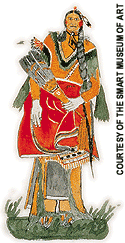The
art of community
 A
few paragraphs from now, I'll talk about Silver Horn, the Kiowa
artist who was the subject of a spring exhibition at the Smart
Museum, "Transforming Images"--and whose self-portrait is shown
at right. But first, a local detour.
A
few paragraphs from now, I'll talk about Silver Horn, the Kiowa
artist who was the subject of a spring exhibition at the Smart
Museum, "Transforming Images"--and whose self-portrait is shown
at right. But first, a local detour.
This
issue's cover story, "Hyde Park Revisited," is about another transforming
image: that of the University's neighborhood. Like the rest of
Chicago's South Side, we're "hot." That's good, right?
I
once read a poem with the wonderful line, "California is Christianity
with the conveniences." Longtime Hyde Parkers sometimes worry
that, with the advent of the conveniences, they may lose their
true faith: Because 62 percent of the faculty live within walking
distance of campus, the neighborhood, like the University, is
truly a community of scholars. What if the rising real-estate
tide changes that?
For
a non-scholar, living where you work has advantages, too. Take,
for example, the Silver Horn exhibit. Despite press releases and
stories in the campus and city papers, I showed up at the scholarly
symposium held in conjunction with the exhibition, solely because
a former next-door neighbor, an art historian who's now moved
five minutes away, told me I'd be a fool to miss it.
He
was right, just as my other neighbors are so often right about
so many other things that I might like to read, know, do, or think
about. While it's nice to be able to get a cup of Starbucks or
a boutique bagel in Hyde Park these days, you can do that in lots
of places. What you can't always get is the special community--which
may be what the newcomers want, too.
Returning
to Silver Horn: Outside the Oriental Institute, pewter-colored
clouds gathered for a morning thunderstorm. Inside, the paneled
walls of Breasted Hall glowed equally dark. A score of academics
chatted softly in the auditorium's front rows. Moving from group
to group was a middle-aged man in business suit, white shirt,
and striking tie--wider than a bolo, narrower than a belt, as
brightly colored as a rag rug. When Robert G. Donnelley, AM'97--businessman
turned museum director turned Ph.D. student in art history at
Chicago and guest curator for "Transforming Images: The Art of
Silver Horn and His Successors"--came to the podium, he explained
that the project's Kiowa mentor had given him the tie, asking
him to wear it whenever the exhibition was discussed.
A
painter has the right
to paint only what he owns. The "he" is
deliberate.
|
Listening
to the first speaker--Candace S. Greene, an ethnologist with the
Smithsonian's National Museum of Natural History and author of
the forthcoming Silver Horn: Master Illustrator of the Sioux--it
became apparent that, in wearing the tie, Donnelley was not simply
respecting the wishes of a friend, he was also acknowledging important
Kiowa tenets.
The
Kiowa believe, Greene said, in the rights of representation, a
version of intellectual property in which one owns one's own history
and one's deeds. A painter has the right to paint only what he
owns. The "he" is deliberate. Until reservation days, painting
was man's work, on man's subjects. Most Kiowa art was a public
accounting of a warrior's accomplishments--"counting coup," or
strokes of war. Defeated by the U.S. government, the painters'
traditional subject was gone.
Too
young to take part in the Kiowa's last battles, Silver Horn spent
most of his life on an Oklahoma reservation. When he died in 1940
at age 80, he left more than 1,000 works--some traditional, others
influenced by Western style. He painted on animal hides; he drew
in ledgers and notebooks. He recorded war deeds; he illustrated
folklore and myths. Some of his works--deliberately generic, not
borrowing from any individual's experience--were made to be sold.
A mentor to young artists, he saw Kiowa art move from the personal
to the community, from biography to history, from I to we. --M.R.Y.


![]()
 A
few paragraphs from now, I'll talk about Silver Horn, the Kiowa
artist who was the subject of a spring exhibition at the Smart
Museum, "Transforming Images"--and whose self-portrait is shown
at right. But first, a local detour.
A
few paragraphs from now, I'll talk about Silver Horn, the Kiowa
artist who was the subject of a spring exhibition at the Smart
Museum, "Transforming Images"--and whose self-portrait is shown
at right. But first, a local detour.